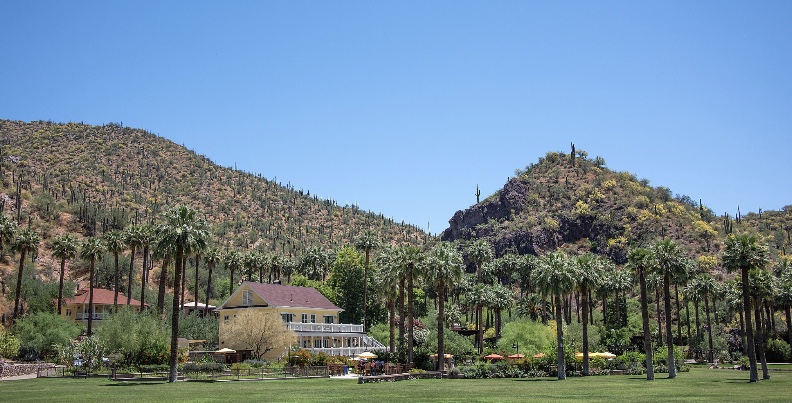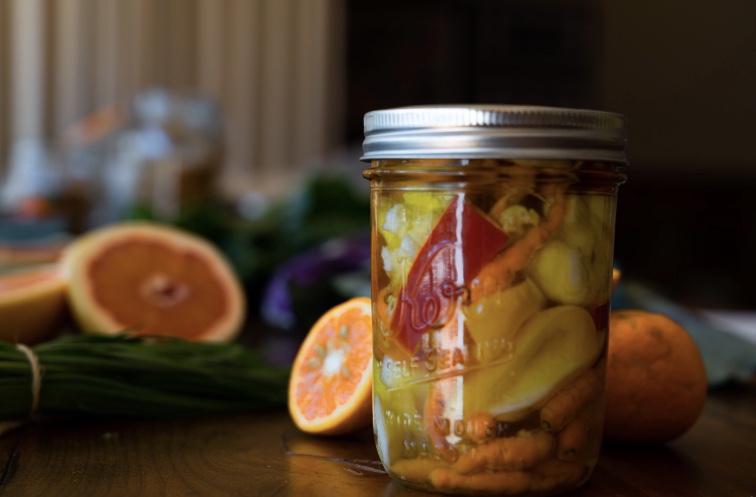By Rebecca L. Rhoades
The farm-to-table movement began in the late decades of the 20th century. Its goal was to bring diners closer to the food they eat by having restaurants source produce and proteins from local farms. Luxury resorts on expansive swathes of agricultural land, such as Tennessee’s Blackberry Farm, took the concept a step further by growing produce on-site, ensuring that their culinary venues offered the freshest and highest-quality organic food available.
When Arizona’s swanky Castle Hot Springs resort reopened in 2019 after more than 40 years of disuse, its farm program quickly garnered as much attention as did its natural pools of therapeutic mineral-rich thermal water (to learn more about the health benefits of hot springs, see our May 2023 story “Taking the Waters”). The landmark lodging cradled in the foothills of the Bradshaw Mountains about 50 miles north of downtown Phoenix is a verdant oasis tucked into the rocky terrain.
Agronomist Ian Beger has been with the resort since the start of its restoration. Prior to joining the team at Castle Hot Springs, Beger had built a reputation for growing and providing high-end restaurants with specialized vegetables as the owner of Scottsdale’s Brother Nature Farms. As the resort’s farm manager, he helped design and implement the property’s agricultural program.

Initially, the resort had a single garden — a fan-shaped planting area that stretched out from the southwest corner of the main lodge, a canary-yellow structure that houses the property’s restaurant, Harvest, and lounge, Bar 1896. Known as the culinary garden, it provided kitchen staff with instant access to ingredients such as herbs, microgreens, and edible flowers.
“We realized after the first year that we wanted to provide more of the substance of the food — the carrots, the cauliflower, broccoli — but we really couldn’t provide most of that from this space,” Beger says.
With the addition of a one-acre vegetable garden, multiple high tunnel greenhouses, and a large glass greenhouse in which Beger and farm operations manager David Bullock grow and breed tomatoes — along with a three-acre agave farm, a quarter-acre of stone fruit trees, and a citrus orchard — Castle Hot Springs now offers five acres of cultivable space.
“Our main goal is to provide the best quality fruits, vegetables, and herbs to the kitchen, the bar and, ultimately, our guests. And we’re trying to do that in a sustainable and delicious way,” Beger says. “We’re focused on flavor more than anything else.”
GROWING SUBHEAD
 Gardening in the Sonoran Desert can be challenging due to the region’s extreme heat, low humidity, and poor soil quality. The landscape at Castle Hot Springs also offers additional characteristics that must be taken into consideration.
Gardening in the Sonoran Desert can be challenging due to the region’s extreme heat, low humidity, and poor soil quality. The landscape at Castle Hot Springs also offers additional characteristics that must be taken into consideration.
“We have very unique growing conditions. It’s unlike anywhere else that I’ve ever grown before,” Beger explains. The main water source is the property’s spring water, which has a high mineral content. The water infuses the crops with a distinctive minerality and flavor.
The farm team takes what Beger calls “a shotgun approach” to agriculture. “We try out as many varieties as we can, see what works and what doesn’t, and then double down on the ones that are growing well,” he says. “We’re a pretty experimental farm.”
To find produce that thrives in the desert — and that brings robust flavors to the plate — the farmers have trialed more than 1,000 varieties. Each year, about 30 percent of the crops sowed are new. Typically, new crops comprise only about 10% of a traditional farm’s annual production.
In addition to growing Southwest garden staples, such as cucumbers, onions, strawberries, asparagus, and a variety of peppers, Beger and his team cultivate some unusual varieties of produce.
One of the most popular is mokum carrots. Small in size and sweet in flavor, they store longer than other varieties.
“It’s the best carrot you’ll ever have,” says Castle Hot Springs Executive Chef John Amman, who uses the root vegetable to create the popular mokum carrot soup. “We include some of our citrus, lime leaves, coconut milk, fresh ginger, and herbs, such as Texas tarragon or Mexican oregano. And because we use the mokum carrots, we don’t need to add a sweetener to it. The carrots are as sweet as candy, and that makes a substantial impression on the dish. People come back just for the mokum carrot soup.”
For the past five years, Beger and Bullock have been growing and breeding tomatoes. At one point, they were cultivating about 45 different kinds. Currently, the greenhouse holds about 15 varieties, from large heirlooms to petite, juicy cherries.
The pair uses a production method called “high-wire,” in which vines are trellised upward on wires. This system allows the plants to grow continuously throughout the year and produces an enormous amount of tomatoes in a relatively small space.
“It’s the highest yield per square foot way of growing tomatoes,” Beger notes. “It’s easy to harvest, but it’s also quite a bit of work. We’re also doing some of our own tomato breeding,” he continues.
Bullock has been working with a cross between the Paul Robeson, a beefsteak variety that’s known as one of the best-tasting tomatoes in the world, and his personal favorite, the Green Doctor, a light green heirloom cherry tomato. Beger hopes his own creation, a cross between the two-tone Lucid Gem and the striped Tigerella that he’s named the Lucid Tiger, will one day become an heirloom variety that’s exclusive to the resort.
“That’s the great thing about having a place like this. Not only is the water here unique, but you have these varieties of tomatoes that you’re never going to get elsewhere,” Bullock says. “It’s exciting.”

At any given time, there are more than 150 varieties of fruits and vegetables in the ground. Produce that’s not consumed immediately is pickled, cured, or fermented, preserving the flavors for out-of-season use. Herbs and flowers are dried for use in teas and simple syrups.
“We’ve done a lot of experimenting in the past five years. Now it’s time to start homing in on those staple varieties,” Beger says, noting that he would like the gardens to eventually provide 80 percent of the produce used by the kitchen. “We’re still going to experiment. That’s something we never want to get away from, but we’ll probably do small batches. Because our goal is to grow the highest-quality vegetables that we can. And sometimes, in order to do that, you need to hunt it down.”
For more information about Castle Hot Springs and its farm program, visit www.castlehotsprings.com
Garden Bounty
More than 150 varieties of fruits – including dozens of types of heirloom tomatoes – vegetables, herbs, and edible flowers are harvested each season at Castle Hot Springs. Here are some of the property’s more unusual offerings:
Blue spice basil (Ocimum basilicum): A key ingredient in Castle Hot Springs’ welcome tea, it features fragrant purple spikes that are covered in lavender flowers. The leaves and flowers taste like bubblegum.
Bronze fennel (Foeniculum vulgare dulce): This aromatic flowering perennial features edible licorice-flavored leaves and seeds. Its yellow flowers attract pollinators.
Dragon tongue (Phaseolus vulgaris): The purple pods of this garden-friendly snap bean can grow as long as eight inches. They’re rich in protein, vitamins, and antioxidants.
Dulce button (Phyla dulcis): An herbaceous plant that’s part of the mint family. Its tiny white flowers are incredibly sweet — up to 1,500 times sweeter than conventional sugar. It’s ideal for use in cocktails.
Epazote (Dysphania ambrosioides): An aromatic leafy herb with edible leaves and stems. It is commonly used to flavor beans.
French sorrel (Rumex scutatus): This leafy herb looks like spinach but has a taste similar to sour green apple.
Glacier lettuce (Mesembryanthemum crystallinum): This edible succulent takes in salt from the water and soil, resulting in a flavor that’s reminiscent of the ocean.
Moringa (Moringa oleifera): A fast-growing, drought-resistant tree. Its leaves and pods are considered a superfood that can benefit everything from skin conditions to high blood pressure to infections.
Sea beans (Salicornia): The flowering succulents with branch-like stalks add a salty crunch to soups and salads. The chefs at Castle Hot Springs also add it to the Green Goddess dressing.
Sonoran passionfruit (Passiflora arizonica): The distinctive purple-blue flowers with pale yellow stamens contain mouthwatering edible pulp.
Texas tarragon (Tagetes lucida): Unlike its French cousin, this perennial grows well in the desert heat. Its flavor and aroma are similar to sweet black licorice.
Variegated Pink Eureka lemon (Citrus limon ‘Variegated Pink Eureka’): This citrus tree with variegated leaves flowers multiple times a year. It produces yellow fruit with green stripes and pink flesh.







